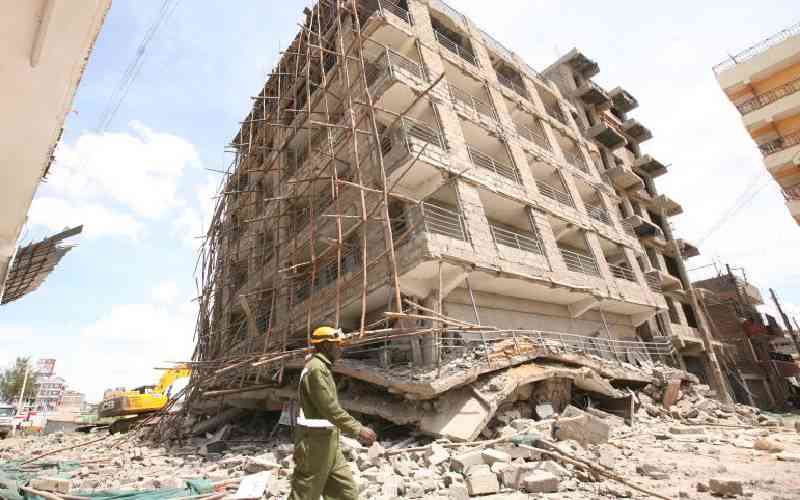. On November 21, barely 24 hours after tenants had been ordered to evacuate, a five-storey building collapsed in Ruiru, Kiambu County.
Tenants had noticed cracks developing on the house which had initially been built to three floors, before the developer added two more floors.
The foundation could no longer hold.
The tenants said the building, which was still under construction at the time of the collapse, had been declared unsafe several times after developing cracks on its walls but the developer brushed aside any, and all, concerns.
https://www.youtube.com/watch?v=_iZ3Uv_euJo
The cracks had then grown at a horrifying rate until scared tenants made a distress call to authorities.
The cries for intervention attracted the attention of the Kiambu County government. The county officials thus kick-started the exit plan, which was a crucial move. No one was hurt when the building tumbled.
Even as authorities labour to ensure all buildings are safe for human occupation, a huge responsibility is placed on the shoulders of the occupiers of such buildings who, in cases where things go wrong, are the casualties.
In a seemingly endless cat-and-mouse chase game between authorities and sneaky developers, the former constantly asks the public to help them nab wily developers constantly endangering lives.
A spate of collapsing buildings in the past few months saw the National Construction Authority (NCA) increase its campaigns for public awareness on social media.
The State agency seeks to have members of the public help identify non-compliant projects or projects that show clear defects, thus making it easy to crack down on such developers and prevent disastrous outcomes.
The campaign includes informing the public on the meaning of markings that are made on construction sites.
“The “NCA X” is used to indicate that a site has been suspended due to failure by the developer or contractor to comply with one or more of the seven requirements that NCA quality assurance officers check for during site inspections,” NCA wrote on Twitter in September 2021, a message it has reiterated the past few months.
It also provides information on the status of professionals in the industry.
“How do you know whether a contractor is in good standing? All contractors who have renewed their annual practising licences are listed on the NCA website,” NCA recently Tweeted. In the list, contractors’ registration numbers, names, towns, categories and classes are listed.
Such reminders on social media, accompanied by links to websites that contain additional information on players in the industry, make the public more active in the fight against unprofessional conduct in the construction industry.
House owners
NCA Executive Director Maurice Akech says tenants should be the first line of defence and can put house owners to task by knowing what to demand for before settling into a house.
“The tenants should demand to see the occupation certificate, which is issued to the developer by the county government once the construction is complete and has followed all the necessary procedures,” says Akech.
An occupation certificate (certificate of occupancy or certificate of occupation), issued by the local authorities, certifies that a building is fit for occupation and has been constructed as per the approved plan and in compliance with local laws.
Once they have seen that certificate and have settled in a building, that is not the end of their duty. Akech says tenants should be on the lookout for anything that might be an indicator of a faulty, or failing, structure.
While the structural soundness of a building can only be ascertained by professionals, some indicators of an unhealthy structure cannot be missed even by the untrained eye.
Take the Leaning Tower of Pisa in Italy, for example. The 56-metre building was completed in 1372 but leaned by just over four degrees due to the unstable foundation.
Repair works over the years reduced the lean angle and the building remains a tourist attraction; the age-old, leaning tower that just refused to crumble hundreds of years later.
To any observer, keen or not, the lean is obvious. Any indicator of an inclination from the vertical, Akech says, should be cause for alarm and should be reported. Often, this is not very difficult to spot.
Other indicators of a faulty structure could be doors and windows suddenly not opening as smoothly as they used to, which could mean a shift in the shape of the structure, a very unnatural happening.
Obvious warning signs
Failing, and falling, ceiling boards, which people sometimes lightly associate with the poor fitting of the boards, could also be a sign that the building is no longer in its soundest shape.
But cracks are the most obvious warning signs. While authorities have been called by worried members of the public after spotting cracks which then turn out to be expansion joints in some of the vaster structures.
People are nonetheless encouraged to report any cracks in buildings without hesitation.
London Building Surveyors writes that cracking in buildings can occur due to the permeability of concrete, thermal movement (caused by the expansion and contraction of the fabric of the building due to hot and cold weather), moisture movement, subsidence and wall tie failure (when the metal ties holding the outside skin of both solid and cavity walls fail).
Subsidence – where shallow foundations, clay sub-soil, tree roots and dry weather cause the foundation to move is one of the most common causes for cracking in, and eventual collapse of, houses.
A contractor registering a proposed construction project with the NCA has to submit the project registration form to the authority with the approved architectural and structural drawings, National Environment Management Authority (Nema) certificate, bill of quantities (BoQ summary), client and contractor-signed contract documents, contractor’s registration certificate, quantity surveyor’s practising certificate, architect’s practising certificate, engineer’s practising certificate and client’s Kenya Revenue Authority (KRA) certificate.
Unscrupulous developers
In spite of all the regulations and the aforementioned requirements, unscrupulous developers find a way to circumvent the law and often bring up shoddy structures and usher in unsuspecting tenants.
“But if every new tenant asks for the certificate of occupation, then every developer will be put under pressure and will seek to have the certificate. They will be forced to do the right thing,” says Akech.
Within the lifetime of a building, structural audit assessments are necessary to ensure the structural integrity of the construction. This is usually done by a structural engineer.
A structure could be unsound and this might not be obvious to the naked eye. Defects could be due to the quality of the material used being substandard, the foundation being poor, or the workmanship being of low quality.
As such, a collaboration between authorities and the public to keenly scrutinise buildings’ health is crucial and is the best way to deal with rogue contractors and save lives.
The public is encouraged to always contact the NCA in case they notice something unusual that they feel could be a precursor for disaster in buildings.
They can also contact the police or the county governments.
“I want to assure the public that the government is constantly working to weed out rogue contractors,” Akech says.
“Every time we receive a signal of something suspicious, we act upon it immediately. Such information helps us react and save lives and bring to book those responsible for putting lives at risk.”





















Discussion about this post